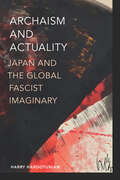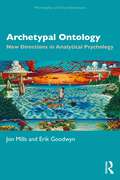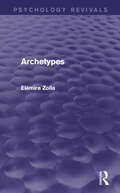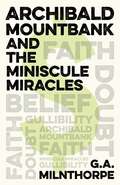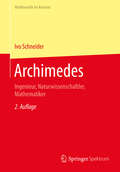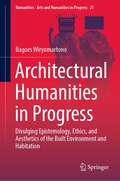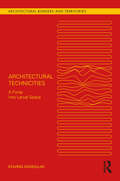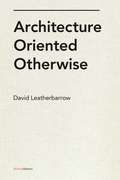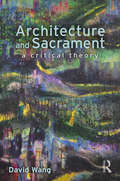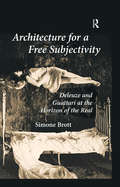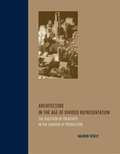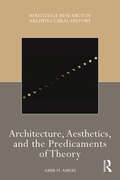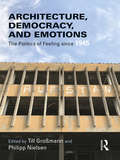- Table View
- List View
Archaism and Actuality: Japan and the Global Fascist Imaginary (Theory in Forms)
by Harry HarootunianIn Archaism and Actuality eminent Marxist historian Harry Harootunian explores the formation of capitalism and fascism in Japan as a prime example of the uneven development of capitalism. He applies his theorization of subsumption to examine how capitalism integrates and redirects preexisting social, cultural, and economic practices to guide the present. This subsumption leads to a global condition in which states and societies all exist within different stages and manifestations of capitalism. Drawing on Japanese philosophers Miki Kiyoshi and Tosaka Jun, Marxist theory, and Gramsci’s notion of passive revolution, Harootunian shows how the Meiji Restoration of 1868 and its program dedicated to transforming the country into a modern society exemplified a unique path to capitalism. Japan’s capitalist expansion in the nineteenth and twentieth centuries, rise as an imperial power, and subsequent transition to fascism signal a wholly distinct trajectory into modernity that forecloses any notion of a pure or universal development of capitalism. With Archaism and Actuality, Harootunian offers both a retheorization of capitalist development and a reinterpretation of epochal moments in modern Japanese history.
Archetypal Ontology: New Directions in Analytical Psychology (Philosophy and Psychoanalysis)
by Jon Mills Erik GoodwynIn this novel re-examination of the archetype construct, philosopher Jon Mills and psychiatrist Erik Goodwyn engage in spirited dialogue on the origins, nature, and scope of what archetypes actually constitute, their relation to the greater questions of psyche and worldhood, and their relevance for Jungian studies and analytical psychology today.Arguably the most definitive feature of Jung’s metapsychology is his theory of archetypes. It is the fulcrum on which his analytical depth psychology rests. With recent trends in post-Jungian and neo-Jungian perspectives that have embraced developmental, relational, social justice, and postmodern paradigms, classical archetype theory has largely become a drowning genre. Despite the archetypal school of James Hillman and his contemporaries, and the archetype debates that captured our attention over two decades ago, contemporary Jungians are preoccupied with the lived reality of the existential subject and the personal unconscious over the collective transpersonal forces derived from archaic ontology. Archetypal Ontology will be of interest to psychoanalysts, philosophers, transpersonal psychologists, cultural theorists, anthropologists, religious scholars, and scholars in many disciplines in the arts and humanities, analytical psychology, and post-Jungian studies.
Archetypes (Psychology Revivals)
by Elémire ZollaMan is dominated by his archetypes; they mould not only his history but his dreams. But how are we to define and evaluate them? Is it perhaps possible for us to relate more creatively to them? Originally published in 1981, these are some of the questions raised by this title. To answer them the author gathered together a vast amount of material drawn from Eastern and Western traditions, from science, literature, art and poetry. The answers he puts forward are often highly original and will surely challenge many of our most cherished patterns of thought. There emerges from this book what can only be described as a global metaphysical system, yet the author’s language is not that of an ordinary metaphysical treatise, and what he writes offered new challenge and hope to those suffering from the despair and cynicism engendered by a great deal in modern society at the time. Zolla does not, however, advocate a return to earlier historical patterns, nor is he proposing a new Utopia, but rather offers us a brilliant series of lessons in the art of centring. In the words of Bernard Wall, writing in the Times Literary Supplement, Zolla’s ‘deep, polymathic probing of the terms of human existence makes it sensible to compare him with Simone Weil, while some of his conclusions about ultimate mysteries – expressed in signs, symbols and sacraments, the sense of which we have lost – will make us think of the later T. S. Eliot’.
Archetypes Of Wisdom: An Introduction To Philosophy
by Douglas SoccioARCHETYPES OF WISDOM: AN INTRODUCTION TO PHILOSOPHY, 8E brings philosophy to life through lively narratives, engaging illustrations, and a student-friendly writing style. Using its signature conversational prose, the textbook guides students through the lives and works of history's greatest philosophers, then brings it all together with helpful study materials in every chapter. Drawing from both canonical primary sources and the latest philosophical critiques, ARCHETYPES OF WISDOM: AN INTRODUCTION TO PHILOSOPHY, 8E makes philosophy approachable and exciting for students.
Archetypes of Thought
by Thomas MolnarIn Archetypes of Thought, originally published in 1991 with the title Philosophical Grounds, Thomas Molnar follows seven basic themes of Western philosophical speculation from their development in the earliest times of systematic thought through their evolution through the centuries and civilizations to the present. Some of the themes are origin and its reflection, guilt of being, one and the multiple, the temptation of mechanization, and nocturnal man. The book is neither a chronological treatment of issues nor a list of philosophical schools and movements. Rather, it reaches for the archetypes of philosophical reasoning. Molnar shows the presence of modern themes in the entire history of thinking, traces technology to the first stirrings of rationalism, and evinces modern man's feeling of culpability. Throughout, the soul is perceived as the keeper of God's and man's secret, one which reflects reality and also tries to organize it according to an ontologically implanted rhythm. In his new introduction, Molnar explains and re-examines his reasons for writing the book. While the themes he covers have been widely dealt with in contemporary thought, they are brought together to form an original combination of philosophical concepts. Archetypes of Thought is an intriguing study of the evolution of philosophical thinking. It is essential reading for both students and professionals of philosophy, history, and sociology.
Archetypes of Wisdom: An Introduction to Philosophy
by Douglas SoccioFeaturing lucid and conversational prose and a well-chosen, reader-friendly array of succinct excerpts from canonical primary sources, ARCHETYPES OF WISDOM: AN INTRODUCTION TO PHILOSOPHY, 7E brings philosophy to life for readers. Extremely reader friendly, this test examines philosophies and philosophers while using numerous pedagogical illustrations, special features, and an approachable page design to make this oftentimes daunting subject more engaging. The Seventh Edition represents a careful revision, focused on enhancing the book's reader-praised "search for wisdom" motif. This edition is supported by an unmatched array of teaching and learning resources including an online resource center with dynamic, easy-to-use lecture and class preparation tools.
Archibald Mountbank and the Miniscule Miracles
by G. A. MilnthorpeArchibald Mountbank has the power to make almost anything 1% better. Whether you want to be 1% better looking or 1% taller, Archibald Mountbank is your man. He can even boost your immune system or your willpower... for a fee. Archibald Mountbank, one of the richest (and most hated) men in Britain, is about to retire from his highly contentious "profession". But before he retires, Mountbank's Commercial Manager has accepted an offer to allow Mountbank to be shadowed by a journalist. Alistair Dodd, a cynical journalist commissioned to write a hatchet job biography, gets a rare look into the life and practices of the elusive Mountbank and discovers that everyone needs to believe in something... it's just a question of what.
Archimedes and the Door of Science
by Jeanne BendickJeanne Bendick, through text and pictures, admirably succeeds in bringing to life the ancient Greek mathematician who enriched mathematics and all branches of science. Against the backdrop of Archimedes' life and culture, the author discusses the man's work, his discoveries and the knowledge later based upon it. The simple, often humorous, illustrations and diagrams greatly enhance the text.
Archimedes in the 21st Century: Proceedings of a World Conference at the Courant Institute of Mathematical Sciences (Trends in the History of Science)
by Chris RorresThis book is a collection of papers presented at the "Archimedes in the 21st Century" world conference, held at the Courant Institute of Mathematical Sciences in 2013. This conference focused on the enduring and continuing influence of Archimedes in our modern world, celebrating his centuries of influence on mathematics, science, and engineering. Archimedes planted the seeds for a myriad of seminal ideas that would grow over the ages. Each chapter surveys the growth of one or more of these seeds, and the fruit that they continue to bear to this day. The conference speakers contributing to this book are actively involved in STEM fields whose origins trace back to Archimedes, many of whom have conducted and published research that extends Archimedes' work into the 21st century. The speakers are not historians, so while historical context is provided, this book is uniquely focused on the works themselves as opposed to their history. The breadth and depth of Archimedes' influence will inspire, delight, and even surprise readers from a variety of fields and interests including historians, mathematicians, scientists, and engineers. Only a modest background in math is required to read this book, making it accessible to curious readers of all ages.
Archimedes: Ingenieur, Naturwissenschaftler, Mathematiker (Mathematik im Kontext)
by Ivo SchneiderEin Meilenstein der Archimedes-Forschung wieder verfügbar! Ausgestattet mit einem umfangreichen neuen Vorwort, das auf die neueren Forschungsergebnisse eingeht, wird in diesem wegweisenden Werk die bis heute ungeklärte Kernfrage der Archimedes-Forschung behandelt: Ist Archimedes von der Praxis des Architekten, Geschütz- und Instrumentenbauers über die Mechanik zur Mathematik gekommen, oder hat er als Mathematiker die Mechanik zu einer mathematischen Disziplin gemacht, für die er später Anwendungen suchte? Über die Rekonstruktion des Lebens und des Werkes von Archimedes werden seine außermathematischen Aktivitäten und Leistungen mit denen des Mathematikers in einen Zusammenhang gebracht und so die z. T. auseinanderstrebende Ergebnisse der Forschung in den letzten Jahrzehnten harmonisiert. Durch seinen stringenten Aufbau führt das Buch bestens in die Biographie und das Werk von Archimedes ein und zeigt dabei auch, welche z. T. großen Erkenntnislücken wir heute noch über Archimedes haben.
Architectural Drawings as Investigating Devices: Architecture’s Changing Scope in the 20th Century (Routledge Research in Architecture)
by Marianna CharitonidouArchitectural Drawings as Investigating Devices explores how the changing modes of representation in architecture and urbanism relate to the transformation of how the addressees of architecture and urbanism are conceived. The book diagnoses the dominant epistemological debates in architecture and urbanism during the 20th and 21st centuries. It traces their transformations, paying special attention to Le Corbusier and Ludwig Mies van der Rohe’s preference for perspective representation, to the diagrams of Team 10 architects, to the critiques of functionalism, and the upgrade of the artefactual value of architectural drawings in Aldo Rossi, John Hejduk, Peter Eisenman, and Oswald Mathias Ungers, and, finally, to the reinvention of architectural programme through the event in Bernard Tschumi and the Office for Metropolitan Architecture (OMA). Particular emphasis is placed on the spirit of truth and clarity in modernist architecture, the relationship between the individual and the community in post-war era architecture, the decodification of design process as syntactic analogy and the paradigm of autonomy in the 1970s and 1980s architecture, the concern about the dynamic character of urban conditions and the potentialities hidden in architectural programme in the post-autonomy era. This book is based on extensive archival research in Canada, the USA and Europe, and will be of interest to architects, artists, researchers and students in architecture, architectural history, theory, cultural theory, philosophy and aesthetics.
Architectural Humanities in Progress: Divulging Epistemology, Ethics, and Aesthetics of the Built Environment and Habitation (Numanities - Arts and Humanities in Progress #21)
by Bagoes WiryomartonoThis monograph brings three branches of philosophy together: epistemology, ethics and aesthetics. It assesses the built environment as a case study from a phenomenological perspective. Under the notion of phenomenology, this study understands the built environment as the hermeneutical phenomenon of being in the life-world that is experienced by people within the socio-cultural and historical context of habitation. Hermeneutically, the built environment as a phenomenon is contextually interwoven with other phenomena within the socio-cultural, historical, and environmental network. Phenomenologically speaking, the task of the study is to excavate, listen to, unfold, divulge, and reconstruct the socio-culturally, environmentally, and historically constructed relationship between people and their built environment that build, develop, and elaborate the system of knowledge, ethics, and aesthetics. By and large, its nature and findings are theoretical and interdisciplinary, so it will be of interest not only for philosophers, but also to scholars studying urban development and anthropology.
Architectural Technicities: A Foray Into Larval Space (Architectural Borders and Territories)
by Stavros KousoulasThis book poses a simple question: how is this architecture possible? To respond, it will embark on a captivating journey through many singular architectural concepts. The entasis of Doric columns, Ulysses and desert islands will outline an architectural act that moves beyond representation. A ferryman who stutters will present two different types of architectural minds. A stilus and a theory of signs will reconsider the ways architects can develop a particular kind of intuition, while architectural technicities will bring forth a membranic and territorial understanding of architecture. Finally, as a melody that sings itself, a larval architecture will be introduced, bringing space and time together. Assisting this endeavour, the thought of philosophers like Gilles Deleuze, Felix Guattari, Gilbert Simondon and Raymond Ruyer will meet the latest developments in fields like affect theory, cognitive sciences, environmental studies and neuroanthropology. Eventually, by the end of this book, the readers – from architecture students and researchers to academics and practitioners with an interest in theory – will have been exposed to a comprehensive and original philosophy of architecture and the built environment.
Architecture Oriented Otherwise
by David Leatherbarrow<p>So much writing about architecture tends to evaluate it on the basis of its intentions: how closely it corresponds to the artistic will of the designer, the technical skills of the builder, or whether it reflects the spirit of the place and time in which it was built, making it not much more than the willful (or even subconscious) assemblage of objects that result from design and construction techniques. <p>Renowned writer and thinker David Leatherbarrow, in this groundbreaking new book, argues for a richer and more profound, but also simpler, way of thinking about architecture, namely on the basis of how it performs. Not simply how it functions, but how it acts, "its manner of existing in the world," including its effects on the observers and inhabitants of a building as well as on the landscape that situates it. In the process, Leatherbarrow transforms our way of discussing buildings from a passive technical or programmatic assessment to a highly active and engaged examination of the lives and performances, intended and otherwise, of buildings.</p>
Architecture against Democracy: Histories of the Nationalist International
by Claire Zimmerman Reinhold MartinExamining architecture&’s foundational role in the repression of democracy Reinhold Martin and Claire Zimmerman bring together essays from an array of scholars exploring the troubled relationship between architecture and antidemocratic politics. Comprising detailed case studies throughout the world spanning from the early nineteenth century to the present, Architecture against Democracy analyzes crucial occasions when the built environment has been harnessed as an instrument of authoritarian power. Alongside chapters focusing on paradigmatic episodes from twentieth-century German and Italian fascism, the contributors examine historic and contemporary events and subjects that are organized thematically, including the founding of the Smithsonian Institution, Ellis Island infrastructure, the aftermath of the Paris Commune, Cold War West Germany and Iraq, Frank Lloyd Wright&’s domestic architecture, and Istanbul&’s Taksim Square. Through the range and depth of these accounts, Architecture against Democracy presents a selective overview of antidemocratic processes as they unfold in the built environment throughout Western modernity, offering an architectural history of the recent &“nationalist international.&” As new forms of nationalism and authoritarian rule proliferate across the globe, this timely collection offers fresh understandings of the role of architecture in the opposition to democracy. Contributors: Esra Akcan, Cornell U; Can Bilsel, U of San Diego; José H. Bortoluci, Getulio Vargas Foundation; Charles L. Davis II, U of Texas at Austin; Laura diZerega; Eve Duffy, Duke U; María González Pendás, Cornell U; Paul B. Jaskot, Duke U; Ana María León, Harvard U; Ruth W. Lo, Hamilton College; Peter Minosh, Northeastern U; Itohan Osayimwese, Brown U; Kishwar Rizvi, Yale U; Naomi Vaughan; Nader Vossoughian, New York Institute of Technology and Columbia U; Mabel O. Wilson, Columbia U.
Architecture and Objects (Art After Nature)
by Graham HarmanThinking through object-oriented ontology—and the work of architects such as Rem Koolhaas and Zaha Hadid—to explore new concepts of the relationship between form and function Object-oriented ontology has become increasingly popular among architectural theorists and practitioners in recent years. Architecture and Objects, the first book on architecture by the founder of object-oriented ontology (OOO), deepens the exchange between architecture and philosophy, providing a new roadmap to OOO&’s influence on the language and practice of contemporary architecture and offering new conceptions of the relationship between form and function. Graham Harman opens with a critique of Heidegger, Derrida, and Deleuze, the three philosophers whose ideas have left the deepest imprint on the field, highlighting the limits of their thinking for architecture. Instead, Harman contends, architecture can employ OOO to reconsider traditional notions of form and function that emphasize their relational characteristics—form with a building&’s visual style, function with its stated purpose—and constrain architecture&’s possibilities through literalism. Harman challenges these understandings by proposing de-relationalized versions of both (zero-form and zero-function) that together provide a convincing rejoinder to Immanuel Kant&’s dismissal of architecture as &“impure.&”Through critical engagement with the writings of Peter Eisenman and fresh assessments of buildings by Rem Koolhaas, Frank Gehry, and Zaha Hadid, Architecture and Objects forwards a bold vision of architecture. Overcoming the difficult task of &“zeroing&” function, Harman concludes, would place architecture at the forefront of a necessary revitalization of exhausted aesthetic paradigms.
Architecture and Progress: Exploring a Progressively Problematic Built Environment
by Matt Hall Mark Alan BlumbergThis volume proposes an interdependent relationship between progress and obstacles in architecture and the built environment. It challenges the positive notion of progress, and the conception of progress and obstacle as a dichotomy.For shapers of the world, finding ‘the solution’ is often a mark of progress that becomes embedded in culture, society, and history. Progress is ever-present. Through the exploration of diverse positions in history, theory, and practice, this book explores the potential utility of the progressively problematic rather than the natural tendency towards the progressively solved. Chapters draw on historic spaces, technological advancement, incorporation of the natural world, alterative production, and the consideration of human experience both sensory and psychological. Challenging the positive connotation of ‘progress’, the writings also explore reversing the notion of obstacle from disruptive anti-tool to obstacle of utilitarian method, a useful tool, pressing approach, and overarching value system.This will be interesting reading for upper-level students and scholars of Architecture, Urban Design, Philosophy, and Sociology.
Architecture and Sacrament: A Critical Theory
by David WangDavid Wang’s Architecture and Sacrament considers architectural theory from a Christian theological perspective, specifically, the analogy of being (analogia entis). The book tracks social and cultural reasons why the theological literature tends to be separate from contemporary architecture theory. Wang argues that retrieval of the sacramental outlook embedded within the analogy of being, which informed centuries of art and architecture in the West, can shed light on current architectural issues such as "big box stores," the environmental crisis and the loss of sense of community. The book critiques the materialist basis of current architectural discourse, subsumed largely under the banner of critical theory. This volume on how European ideas inform architectural theory complements Wang’s previous book, A Philosophy of Chinese Architecture: Past, Present, Future, and will appeal to architecture students and academics, as well as those grappling with the philosophical moorings of all built environments.
Architecture and its Ethical Dilemmas
by Nicholas RayA cast of leading writers and practitioners tackle the ethical questions that architects are increasingly facing in their work, from practical considerations in construction to the wider social context of buildings, their appearance, use and place in the narrative of the environment. This book gives an account of these ethical questions from the perspectives of historical architectural practice, philosophy, and business, and examines the implications of such dilemmas. Taking the current discussion of ethics in architecture on to a new stage, this volume provides an accumulation of diverse opinions, focusing on architects' actions and products that materially affect the lives of people in all urbanized societies.
Architecture for a Free Subjectivity: Deleuze and Guattari at the Horizon of the Real
by Simone BrottArchitecture for a Free Subjectivity reformulates the French philosopher Gilles Deleuze's model of subjectivity for architecture, by surveying the prolific effects of architectural encounter, and the spaces that figure in them. For Deleuze and his Lacanian collaborator Félix Guattari, subjectivity does not refer to a person, but to the potential for and event of matter becoming subject, and the myriad ways for this to take place. By extension, this book theorizes architecture as a self-actuating or creative agency for the liberation of purely "impersonal effects." Imagine a chemical reaction, a riot in the banlieues, indeed a walk through a city. Simone Brott declares that the architectural object does not merely take part in the production of subjectivity, but that it constitutes its own. This book is to date the only attempt to develop Deleuze's philosophy of subjectivity in singularly architectural terms. Through a screening of modern and postmodern, American and European works, this provocative volume draws the reader into a close encounter with architectural interiors, film scenes, and other arrangements, while interrogating the discourses of subjectivity surrounding them, and the evacuation of the subject in the contemporary discussion. The impersonal effects of architecture radically changes the methodology, just as it reimagines architectural subjectivity for the twenty-first century.
Architecture in the Age of Divided Representation: The Question of Creativity in the Shadow of Production
by Dalibor VeselyIn this long-awaited work, Dalibor Vesely proposes an alternative to the narrow vision of contemporary architecture as a discipline that can be treated as an instrument or commodity.
Architecture of the Possible
by Tristan Garcia Jean-Marie DurandAs a philosopher and a novelist, Tristan Garcia inhabits two worlds, metaphysics and literary fiction, like an amphibious creature moving between the land and the sea, breathing in both air and water. He is drawn to metaphysics because, as he puts it, metaphysics is the edge of the abyss of thought, the unstable frontier of indeterminacy where thinking is no longer constrained by the principles of logic or the law of non-contradiction. Metaphysics seeks to describe the world from outside one&’s own point of view. It aims at an ecstatic reconstruction of what keeps us locked up in our conditions, in our time and place, here among the living, with our subjectivities and within our situations. It gives us an idea of all constraints from a point of view that posits the possible absence of the constraint of having a point of view. The ambition of this slender book – which is at the same time a concise introduction to Garcia&’s work and thought – is to help us grasp and transform the conditions of our existence by paying equal attention to what is ending and what is just beginning, to the dusk and to the dawn. Until we cannot hold our breath any longer.
Architecture, Aesthetics, and the Predicaments of Theory (Routledge Research in Architectural History)
by Amir H AmeriArchitecture, Aesthetics, and the Predicaments of Theory offers a critical analysis of the methodological constants and shared critical strategies in the history of theoretical discourse on Western architecture. Central to these constants is the persistent role of aesthetics as a critical tool for the delimitation of architecture. This book analyzes the unceasing critical role aesthetics is given to play in the discourse of architecture. The book offers a close and critical reading of three seminal texts from three different periods in the history of theoretical discourse on Western architecture—the Renaissance, the Enlightenment, and 19th-century Romanticism. The first text is Leone Battista Alberti's Ten Books on Architecture of 1452, the next Marc-Antoine Laugier’s An Essay on Architecture of 1753, and last, John Ruskin’s The Seven Lamps of Architecture of 1849. Additional influential texts from, among others, the 20th and 21st centuries are engaged with along the way to locate and contextualize the arguments within the broader discursive tradition of Western architecture. The book will interest scholars and students of architecture, architectural history and theory, as well as scholars and students of cultural studies, aesthetic philosophy, art history, literary criticism, and related disciplines.
Architecture, Democracy and Emotions: The Politics of Feeling since 1945
by Till Großmann Philipp NielsenAfter 1945 it was not just Europe’s parliamentary buildings that promised to house democracy: hotels in Turkey and Dutch shopping malls proposed new democratic attitudes and feelings. Housing programs in the United Kingdom, the United States, and the Soviet Union were designed with the aim of creating new social relations among citizens and thus better, more equal societies. Architecture, Democracy, and Emotions focuses on these competing promises of consumer democracy, welfare democracy, and socialist democracy. Spanning from Turkey across Eastern and Western Europe to the United States, the chapters investigate the emotional politics of housing and representation during the height of the Cold War, as well as its aftermath post-1989. The book assembles detailed research on how the claims and aspirations of being "democratic" influenced the affects of architecture, and how these claims politicized space. Architecture, Democracy, and Emotions contributes to the study of Europe’s "democratic age" beyond Cold War divisions without diminishing political differences. The combination of an emotional history of democracy with an architectural history of emotions distinguishes the book’s approach from other recent investigations into the interconnection of mind, body, and space.
Architectures of Economic Subjectivity: The Philosophical Foundations of the Subject in the History of Economic Thought (Routledge Frontiers of Political Economy)
by Sonya ScottThe history of European economic thought has long been written by those seeking to prove or disprove the truth-value of the theories they describe. This work takes a different approach. It explores the philosophical groundwork of the theoretical structure within which economic subjects are presented. Demonstrating how the subjects of economic texts tend to be defined in and through their relationship to knowledge, this study addresses the epistemological constitution of subjectivity in economic thought.
